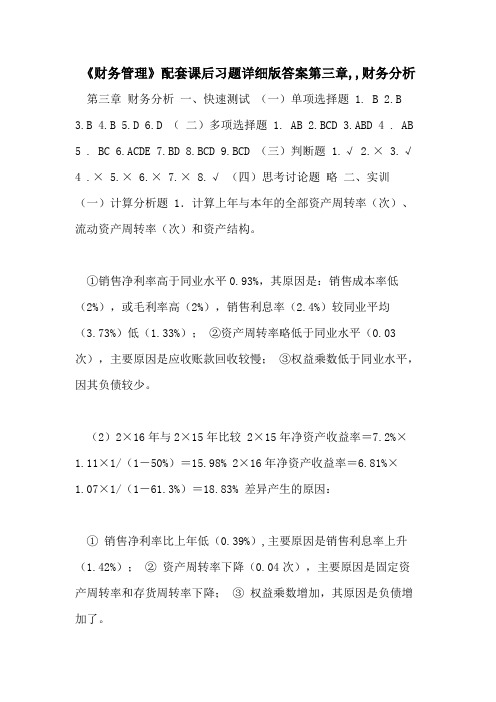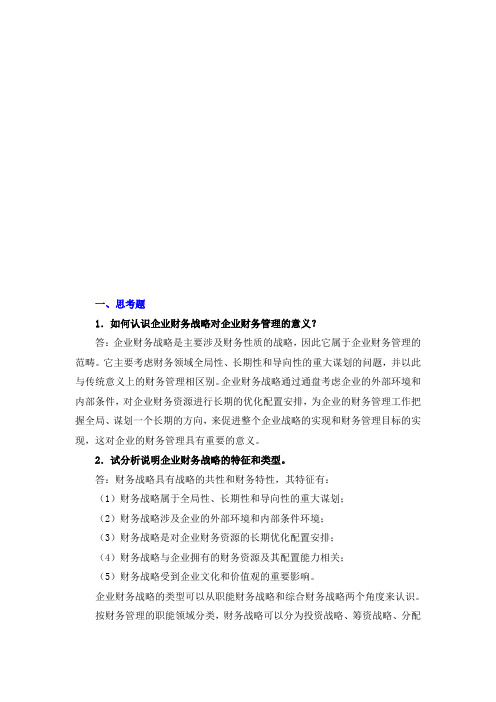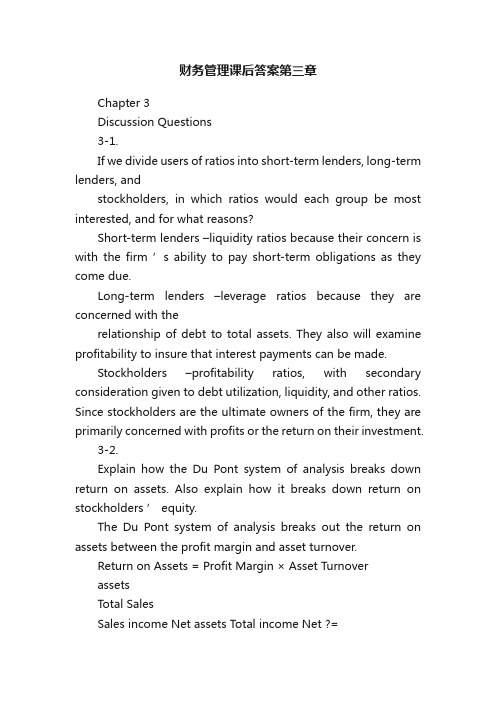财务管理课后答案第三章
财务管理第三章习题及答案

-、单项选择题1.下列关于弹性预算法的说法中,不正确的是()。
A.弹性预算法是为了弥补固定预算法的缺陷而产生的B.弹性预算法的编制是根据业务量、成本、利润的依存关系C.弹性预算法所依据的业务量只能是产量或销售量D.弹性预算法的适用范围大2.编制生产预算中的“预计生产量”时,不需要考虑的因素是()。
A.预计销售量B.预计产成品期初结存量C.预计产成品期末结存量D.前期实际销量3.下列计算等式中,不正确的是()。
A.本期生产数量=本期销售数量+期末产成品结存量-期初产成品结存量B.本期购货付现=本期购货付现部分+以前期赊购本期付现的部分C.本期材料采购数量=本期生产耗用数量+期末材料结存量-期初材料结存量D.本期销售商品所收到的现金=本期的销售收入+期末应收账款-期初应收账款4.某公司2011年1~4月份预计的销售收入分别为100万元、200万元,300万元和400万元,每月材料采购额按照下月销售收入的80%确定,采购当月付现60%,下月付现40%。
假设没有其他购买业务,则2011年3月31日资产负债表“应付账款”项目金额为()万元。
A.148B.218C.150D.1285.能够保证预算期间与会计期间相对应的预算编制方法是()。
A.弹性预算法B.零基预算法C.定期预算法D.固定预算法6.下列不涉及现金收支的预算是()。
A.销售预算B.生产预算C.制造费用预算D.直接人工预算7.下列各项中,属于业务预算的是()。
A.资产负债表预算B.利润表预算C.现金预算D.销售预算8.某企业预计前两个季度的销量为1000件和1200件,期末产成品存货数量-般按下季销量的10%安排,则第-季度的预算产量为()件。
A.1020B.980C.1100D.10009.企业按弹性预算法编制费用预算,预算直接人工工时为100000小时,变动成本为60万元,固定成本为30万元,总成本费用为90万元;如果预算直接人工工时达到120000小时,则总成本费用为()万元。
(完整版)财务管理第三章习题及答案

(完整版)财务管理第三章习题及答案第三章财务分析⼀、单项选择题1、下列经济业务会使企业的速动⽐率提⾼的是( )。
A、销售库存商品B、收回应收账款C、购买短期债券D、⽤固定资产对外进⾏长期投资2、下列财务⽐率中,可以反映企业偿债能⼒的是( )。
A、平均收款期B、销售利润率C、市盈率D、已获利息倍数3、下列不属于偿债能⼒分析指标的是()。
A、资产负债率B、现⾦⽐率C、产权⽐率D、安全边际4、下列财务⽐率中综合性最强、最具有代表性的指标是()。
A 、资产周转率B、净值报酬率C 、资产负债率D 、资产净利率5、流动⽐率⼩于1时,赊购原材料若⼲,将会( )。
A、增⼤流动⽐率B、降低流动⽐率C、降低营运资⾦D、增⼤营运资⾦6、在计算速动⽐率时,要把存货从流动资产中剔除的原因,不包括( )A、可能存在部分存货已经损坏但尚未处理的情况B、部分存货已抵押给债权⼈C、可能存在成本与合理市价相差悬殊的存货估价问题D、存货可能采⽤不同的计价⽅法7、不影响应收账款周转率指标利⽤价值的因素是( )。
A、销售折让与折扣的波动B、季节性经营引起的销售额波动C、⼤量使⽤分期付款结算⽅式D、⼤量使⽤现⾦结算的销售8、ABC公司⽆优先股,去年每股盈余为4元,每股发放股利2元,保留盈余在过去⼀年中增加了500万元。
年底每股账⾯价值为30元,负债总额为5000万元,则该公司的资产负债率为( )。
A、30%B、33%C、40%D、44%9、在杜邦财务体系中,假设其他情况相同,下列说法中错误的是( )A、权益乘数⼤则财务风险⼤B、权益乘数⼤则权益净利率⼤C、权益乘数等于资产权益率的倒数D、权益乘数⼤则资产净利率⼤10、下列公式中不正确的是( )。
A、股利⽀付率+留存盈利⽐率=1B、股利⽀付率×股利保障倍数=1C、变动成本率+边际贡献率=1D、资产负债率×产权⽐率=111、市净率指标的计算不涉及的参数是( )。
A、年末普通股股数B、年末普通股权益C、年末普通股股本D、每股市价12、⼀般认为,流动⽐率保持在( )以上时,资产的流动性较好。
李海波财务管理第三章习题与答案

第三章筹资管理(一)单项选择题1.企业的筹资渠道有( )。
A.发行股票B发行债券C.国家资本D银行借款.2企业的筹资方式有( )。
A.融资租赁B.民间资本C.外商资本D.国家资本3.企业自留资本的筹资渠道可以采取的筹资方式有( )。
A发行股票筹资B.商业信用筹资C.发行债券筹资D.融资租赁筹资4.在经济周期的( )阶段,企业可以采取长期租赁筹资方式。
A.萧条B.苏醒C.繁荣 D. 衰退5.可以作为比较各类筹资方式好坏的尺度的本钱是( )。
A.个别资本本钱 B 边际资本本钱C.综合伙本本钱 D 资本总本钱6可以作为比较选择追加筹资方案重要依据的本钱是( )。
A.个别资本本钱 B 边际资本本钱C综合伙本本钱 D. 资本总本钱7普通股价钱10 50元,筹资费用每股0. 50元,第一年支付的殷利为1 .50元,股利增加率为5%,则该普通股的本钱最接近于( )。
A. 10. 5%B. 15%C. 20%D. 19%8.符合筹资数量预测的因素分析法的计算公式是( )。
A 资本需要量=上年资本实际平均占用量×(1±预测年度销售增减率)×(1±预测期资本周转速度变更率)B. 资本需要量=(上年资本实际平均占用量一不合理平均占用额)×(1±预测年度销售增减率)X(1±预测期资本周转速度变更率)C资本需要量=(上年资本实际平均占用量一不合理平均占用额)×(1+预测年度销售增减率)×(1+预测期资本周转速度变更率)D资本需要量=(上年资本实际平均占用量±不合理平均占用额)×(1±预测年度销售增减率)×(1±预测期资本周转速度变更率)9. ( )是指发行公司通过证券商等中介机构,向社会公众发售股票,发行公司承担发行责任与风险,证券商不负担风险而只收取必然的手续费。
A.发行 .B. 直接公募发行C.间接公募发行D. 股东优先认购10.( )是指股分公司自行直接将股票出售给投资者,而不通过证券经营机构承销。
财务管理第三章课后练习题及答案

企业财务学第三章习题及答案一、某企业于年初向银行借款50万元购买设备,第一年年末开始还款,每年还款一次,等额偿还,分5年还清,银行借款利率为12%。
要求:计算每年应还款额。
解:根据普通年金计算公式:(元)138696605.3500000*500000*5%,12,====A PVIFA A PVIFA A PVA ni n 由以上计算可知,每年还款138696元。
二、时代公司需要一台设备,买价为1600万元,可用10年。
如果租用,则每年年初需付租金200万元。
除此之外,买与租的其他情况相同。
假设利率为6%。
要求:用数据说明购买与租用何者为优。
解:利用先付年金现值计算公式计算出10年租金的现值。
(万元)32.156006.1*36.7*200%)61(**200)1(**10%,6,==+=+=PVIFA i PVIFA A XPVA n i n由以上计算可知,10年租金现值低于买价,因此租用较优。
三、某企业向银行借入一笔款项,银行贷款的年利率为10%,每年复利一次。
银行规定前10年不用还本付息,但从第11~20年每年年末偿还本息5000元。
要求:计算这笔借款的现值。
解:(元)11860386.0*145.6*5000**5000**10%,1010%,10,,0====PVIF PVIFA PVIF PVIFA A PV mi n i四、C 公司在2003年1月1日发行5年期债券,面值1000元,票面利率10%,于每年12月31日付息,到期一次还本。
要求解答一下问题:(1) 假定2003年1月1日金融市场上与该债券同类风险投资的利率是9%,该债券的发行价应定为多少?(2) 假定1年后该债券的市场价格为1049.06元,该债券于2004年1月1日的到期收益率是多少?(1) 解:元)债券的发行价格(1038.87 3.8897*10%*10000.6499*1000PVIFA *10%*1000PVIF 10009%,59%,5=+=+⨯=(2) 解:4,4,*%10*1000PVIF 10001049.06i i PVIFA +⨯=假设 i=9%,等式右边等于1032,假设i=8%,等式右边等于1066.2 利用插值法,%5.82.106610322.106606.1049%8%9%8=--=--i i。
财务管理第三章答案

第三章财务分析一、选择题1、D2、B[参考答案]答案解析:现金的周转过程主要包括存货周转期、应收账款周转期和应付账款周转期,其中存货周转期是指将原材料转换成产成品并出售所需要的时间;应收账款周转期是指将应收账款转换为现金所需要的时间;应付账款周转期是指从收到尚未付款的材料开始到现金支出之间所用的时间。
3、C4、B5、A6、B7、C8、C[答案解析]总资产周转率=销售收入/[(期初资产总额+期末资产总额)/2 ]=(24+4)/[(100+140)/2]=23.33%9、A[答案解析]总资产周转率=主营业务收入净额 /平均资产总额=主营业务收入净额/(流动资产平均余额+固定资产平均余额)=36000/(4000+8000)=3.010、D11、B[答案解析]财务业绩评价指标中,企业获利能力的基本指标包括净资产收益率和总资产报酬率。
营业利润增长率是企业经营增长的修正指标;总资产周转率是企业资产质量的基本指标;资本保值增值率是企业经营增长的基本指标。
二、多选题1、ABCD2、ABCD3、BCD4、ABCD5、ACD6、ABD三、判断题1、√2、√3、ⅹ4、√5、√6、ⅹ7、ⅹ8、四、计算题1、[参考答案](1)C;(2)D;(3)D120000×39.8%=477602、[参考答案](1)2000年与同业平均比较:本公司净资产收益率=销售净利率×资产周转率×权益乘数=7.2%×1.11×[1÷(1-50%)]=7.2%×1.11×2=15.98%行业平均净资产收益率=6.27%×1.14×[1÷(1-58%)]=6.27%×1.14×2.38=17.01%分析:①销售净利率高于同业水平0.93%,其原因是销售成本率低(2%),或毛利率高(2%),销售利息率(2.4%)较同业(3.73%)低(1.33%)②资产周转率略低于同业水平(0.03次),主要原因是应收账款回收较慢。
2021年《财务管理》配套课后习题详细版答案第三章,,财务分析

《财务管理》配套课后习题详细版答案第三章,,财务分析第三章财务分析一、快速测试(一)单项选择题 1. B 2.B 3.B 4.B 5.D 6.D (二)多项选择题 1. AB 2.BCD 3.ABD 4 . AB 5 . BC 6.ACDE 7.BD 8.BCD 9.BCD (三)判断题 1.√ 2.× 3.√4 .× 5.× 6.× 7.× 8.√(四)思考讨论题略二、实训(一)计算分析题 1.计算上年与本年的全部资产周转率(次)、流动资产周转率(次)和资产结构。
①销售净利率高于同业水平0.93%,其原因是:销售成本率低(2%),或毛利率高(2%),销售利息率(2.4%)较同业平均(3.73%)低(1.33%);②资产周转率略低于同业水平(0.03次),主要原因是应收账款回收较慢;③权益乘数低于同业水平,因其负债较少。
(2)2×16年与2×15年比较 2×15年净资产收益率=7.2%×1.11×1/(1-50%)=15.98% 2×16年净资产收益率=6.81%×1.07×1/(1-61.3%)=18.83% 差异产生的原因:①销售净利率比上年低(0.39%),主要原因是销售利息率上升(1.42%);②资产周转率下降(0.04次),主要原因是固定资产周转率和存货周转率下降;③权益乘数增加,其原因是负债增加了。
(3)权益净利率总的变动为18.83%-15.98%=2.85%,其中:销售净利率变动对权益净利率的影响=(6.81%-7.2%)× 1.11×1/ (1-50%)=-0.87% 总资产周转率变动对权益净利率的影响=6.81%×(1.07-1.11)×1/(1-50%)=-0.54% 资产负债率变动对权益净利率的影响=6.81%×1.07×[1/(1-61.3%)-1/(1-50%)]=4.26% (二)案例分析提示两家公司的理财策略和经营策略 1.销售净利润映的是每百元收入所带来的净利润。
《财务管理》书课后习题第3章参考答案

外部融资需求=[(240+65)/4000-(18+25+7)/4000]*1000-55=[(6%+1.625%)-(0.45%+0.625%+0.175%)]*1000-55=8.75万元
(2)预计留存收益增加额=5000* *[1- (1+10%)]=42.5万元
(5)实际年利率=10%÷(1-20%)=12.5%
实际借款额=13.75÷(1-20%)=17.1875万元
(6)该公司股票的预期报酬率=6%+2*(10.5%-6%)=15%
D0=60万元÷30万股=2元/股
该公司股票的每股价格=2*(1+5%)÷(15%-5%)=21元
《财务管理》参考答案
第三章
1.单项选择
1.B 2.C 3.B 4.B 5.D 6.D 7.A 8.D 9.C 10.B 11.D 12.A 13.A 14.C 15.C
2.多项选择
1.BC 2.AC 3.ABCD 4.BD 5.ABC 6.AD 7.ABCD 8.ABCD 9.BD 10.ABCD 11.AB 12.ABC
3.判断
1.×2.×3.×4.×5.√6.√7.√8.√9.√10.√ 11.× 12.√ 13.√ 14.√ 15.√ 16.× 17.√ 18.√ 19.√ 20.√21.×
4.计算
1.商业信用成本= =36.7%>12%所以,应享受商业折扣。
2.(1)预计销售净利润率= =2.75%
预计留存收益= =40%
外部融资需求=(6%+1.625%)*1000-(0.45%+0.625%+0.75%)*1000-42.5=21.25万元>20万元所以,不可行。
财务管理 第3章 风险与收益(含答案解析)

第三章风险与收益分析一、单选题1。
已知某证券的β系数为2,则该证券( ).A。
无风险B. 有非常低的风险C。
与金融市场所有证券的平均风险一致D. 是金融市场所有证券平均风险的两倍2.投资者由于冒风险进行投资而获得的超过无风险收益率的额外收益,称为投资的( )。
A.实际收益率B.期望报酬率C.风险报酬率D.必要报酬率3.企业某新产品开发成功的概率为80%,成功后的投资报酬率为40%,开发失败的概率为20%,失败后的投资报酬率为-100%,则该产品开发方案的预期投资报酬率为()。
A.18%B.20%C.12%D.40%4.投资者甘冒风险进行投资的诱因是().A.可获得投资收益B.可获得时间价值回报C.可获得风险报酬率D.可一定程度抵御风险5.某企业拟进行一项存在一定风险的完整工业项目投资,有甲、乙两个方案可供选择:已知甲方案净现值的期望值为1000万元,标准离差为300万元;乙方案净现值的期望值为1200万元,标准离差为330万元。
下列结论中正确的是()。
A.甲方案优于乙方案B。
甲方案的风险大于乙方案C.甲方案的风险小于乙方案D。
无法评价甲乙方案的风险大小6.已知甲方案投资收益率的期望值为15%,乙方案投资收益率的期望值为12%,两个方案都存在投资风险.比较甲乙两方案风险大小应采用的指标是()。
A.方差B.净现值C。
标准离差D。
标准离差率7.对于多方案择优,决策者的行动准则应是()。
A。
选择高收益项目B。
选择高风险高收益项目C。
选择低风险低收益项目D. 权衡期望收益与风险,而且还要视决策者对风险的态度而定8.x方案的标准离差是1。
5,y方案的标准离差是1。
4,如x、y两方案的期望值相同,则两方案的风险关系为().A。
x>yB. x<yC.无法确定D.x=y9.合约注明的收益率为().A.实际收益率B.名义收益率C.期望收益率D.必要收益率10.( )以相对数衡量资产的全部风险的大小。
A.标准离差率B.方差C.标准差D.协方差11.下列哪项不属于风险控制对策( )。
00067财务管理第三章练习及答案

第三章财务分析一、单项选择题1、下列关于利润表的说法中,正确的是()。
A.利润表是反映公司在某一特定日期的财务状况的报表B.我国现行财务会计制度规定利润表采用多步式C.利润表是按照“利润=收入-费用”这一公式编制的静态报表D.利润表是以收付实现制为基础编制的【正确答案】:B【答案解析】:利润表是反映公司在一定会计期间经营成果的报表,选项A不正确;利润表是按照“利润=收入-费用”这一公式编制的动态报表,所以选项C不正确;利润表是以权责发生制为基础编制的,所以选项D不正确。
参见教材72页。
2、A企业的资产负债表中应收账款的年初数为360万元、年末数为400万元,应收票据的年初数为50万元,年末数为90万元,利润表中营业收入为4500万元,则应收账款周转天数为()天(一年按360天计算)。
A.36B.40C.36.5D.30.4【正确答案】:A【答案解析】:平均应收账款=(360+400)/2+(50+90)/2=450(万元),应收账款周转率=4500/450=10,应收账款周转天数=360/10=36(天)。
参见教材79页。
3、流动资产占总资产的比重所形成的财务比率属于()。
A.动态比率B.定基比率C.结构比率D.环比比率【正确答案】:C【答案解析】:结构比率又称构成比率,用以计算某项财务指标的各构成部分分别占总体的百分比,反映部分与总体的关系,用以分析构成内容的变化以及对财务指标的影响程度。
所以本题流动资产占总资产的比重所形成的财务比率属于结构比率。
4、比较分析法中的比较会计要素的总量、比较结构百分比和比较财务比率的分类标准是()。
A.按比较对象分类B.按比较时间分类C.按比较指标分类D.按比较内容分类【正确答案】:D【答案解析】:比较分析法中:(1)按比较对象分类可以划分为:实际指标与计划指标比较;实际指标与本公司多期历史指标相比较;本公司指标与国内外同行业先进公司指标或同行业平均水平相比较;(2)按比较内容分类划分为:比较会计要素的总量、比较结构百分比和比较财务比率。
财务管理课后习题答案第3章

一、思考题1.如何认识企业财务战略对企业财务管理的意义?答:企业财务战略是主要涉及财务性质的战略,因此它属于企业财务管理的范畴。
它主要考虑财务领域全局性、长期性和导向性的重大谋划的问题,并以此与传统意义上的财务管理相区别。
企业财务战略通过通盘考虑企业的外部环境和内部条件,对企业财务资源进行长期的优化配置安排,为企业的财务管理工作把握全局、谋划一个长期的方向,来促进整个企业战略的实现和财务管理目标的实现,这对企业的财务管理具有重要的意义。
2.试分析说明企业财务战略的特征和类型。
答:财务战略具有战略的共性和财务特性,其特征有:(1)财务战略属于全局性、长期性和导向性的重大谋划;(2)财务战略涉及企业的外部环境和内部条件环境;(3)财务战略是对企业财务资源的长期优化配置安排;(4)财务战略与企业拥有的财务资源及其配置能力相关;(5)财务战略受到企业文化和价值观的重要影响。
企业财务战略的类型可以从职能财务战略和综合财务战略两个角度来认识。
按财务管理的职能领域分类,财务战略可以分为投资战略、筹资战略、分配战略。
(1)投资战略。
投资战略是涉及企业长期、重大投资方向的战略性筹划。
企业重大的投资行业、投资企业、投资项目等筹划,属于投资战略问题。
(2)筹资战略。
筹资战略是涉及企业重大筹资方向的战略性筹划。
企业重大的首次发行股票、增资发行股票、发行大笔债券、与银行建立长期性合作关系等战略性筹划,属于筹资战略问题。
(3)营运战略。
营运战略是涉及企业营业资本的战略性筹划。
企业重大的营运资本策略、与重要供应厂商和客户建立长期商业信用关系等战略性筹划,属于营运战略问题。
(4)股利战略。
股利战略是涉及企业长期、重大分配方向的战略性筹划。
企业重大的留存收益方案、股利政策的长期安排等战略性筹划,属于股利战略的问题。
根据企业的实际经验,财务战略的综合类型一般可以分为扩张型财务战略、稳增型财务战略、防御型财务战略和收缩型财务战略。
(1)扩张型财务战略。
财务管理 习题第 三 章财务预测与计划

第三章财务预测与计划(答案解析)一、单项选择题。
1.某企业2003年新增留存收益为300万元,所计算的可持续增长率为10%,若2004年不增发新股,且能保持财务政策和经营效率不变,预计2004年的净利润可以达到1210万元,则2004年的股利支付率为()。
A.75.21%B.72.73%C.24.79%D.10%2.企业的外部融资需求的正确估计为()。
A.资产增加—预计总负债—预计股东权益B.资产增加—负债自然增加—留存收益的增加C.预计总资产—负债自然增加—留存收益的增加D.预计总资产—负债自然增加—预计股东权益增加3.某企业上年销售收入为1000万元,若预计下一年通过膨胀率为5%,销售量增长10%,所确定的外部融资占销售增长的百分比为25%,则相应外部应追加的资金为()万元。
A.38.75B.37.5C.25D.25.754.企业2002年的可持续增长率为10%,股利支付率为50%,若预计2003年不增发新股并保持目前经营效率和财务政策,则2003年股利的增长率为()A.10%B.5%C.15%D.12.5%5.甲公司的变动资产销售百分比为50%,变动负债销售百分比为10%。
设甲公司的外部融资销售增长比大于0但不超过0.2,销售净利率为10%,股利支付率为30%,其他条件不变,则甲公司销售增长率的可能区间为()。
A.0~20%B.21.21%~53.85%C.20%~53.85%D.0~21.21%6.下列表达式不正确的是()。
A.实际增长需要资金=实际销售/本年资产周转率B.持续增长需要资金=可持续增长销售/上年资产周转率C.超常部分销售所需资金=实际增长需要资金-持续增长需要资金D.持续增长需要资金=可持续增长销售/本年资产周转率7.在计算可持续增长率时,下列说法不正确的是()。
A.不增发新股,意味着股东权益本期增加等于本期形成的留存收益等于留存收益本期增加B.总资产周转率=本期销售/平均总资产C.资本结构不变意味着资产负债率不变D.经营效率体现于资产周转率和销售净利率,财务政策体现于资产负债率和收益留存率二、多项选择题。
财务管理教材第三章练习题答案

第三章 筹资方式参考答案练习题1加权平均发行在外普通股股数=∑(发行在外普通股股数×发行在外月份)/12=(1000×12+500×6)/12=1250每股利润=净利润/发行在外普通股平均股数=2500/1250=2元市盈率=每股市价/每股利润所以,每股市价=2×30=60元即发行底价为60元每股。
练习题2新股发行时,采取对法人配售和对一般投资者上网发行相结合的方式,通过法人投资者竞价来确定股票发行价格。
一般由主承销商确定发行底价,法人投资者根据自己的意愿申购申报价格和申报股数,申购结束后,由发行人和主承销商对法人投资者的有效预约申购数按照申购价格由高到低进行排序,根据事先确定的累计申购数量与申购价格的关系确定新股发行价格,在申购时,每个法人投资者都有一个申购的上限和下限,申购期间申购资金予以冻结。
50,100;45,400;累计50043,600;累计1100,已超过增发数1000所以该公司确定的股票发行底价为43元。
练习题3企业在购买材料时,若享有折扣,则将折扣折算为年收益率为i=[2%/(1-2%)]×360/(60-20)=18.36%(1)在企业现金不足的情况下,若要享有购买材料的折扣,则企业须向银行借款,而企业贷款要付出的利息率为6%,因为6%<18.36%,即企业贷款购买材料带来的收益大于损失,所以企业应当贷款购买材料。
(2)在企业有支付能力时,若企业将现金用作短期投资,该投资的回报率为12%,因为18.36%>12%,所以企业应将现金用于购买材料。
(3)在企业于90天后有支付能力时,有如下几种情况:企业向银行贷款购买材料,此时企业需要至少贷款70天,则应付利息为;100000×6%×70/360=1173元,而企业购买材料获得的折扣为100000×2%=2000元>1173元,所以,企业净收益=2000-1173=827元,因此,应该贷款。
财务管理课后答案第三章

财务管理课后答案第三章Chapter 3Discussion Questions3-1.If we divide users of ratios into short-term lenders, long-term lenders, andstockholders, in which ratios would each group be most interested, and for what reasons?Short-term lenders –liquidity ratios because their concern is with the firm ’s ability to pay short-term obligations as they come due.Long-term lenders –leverage ratios because they are concerned with therelationship of debt to total assets. They also will examine profitability to insure that interest payments can be made.Stockholders –profitability ratios, with secondary consideration given to debt utilization, liquidity, and other ratios. Since stockholders are the ultimate owners of the firm, they are primarily concerned with profits or the return on their investment.3-2.Explain how the Du Pont system of analysis breaks down return on assets. Also explain how it breaks down return on stockholders ’ equity.The Du Pont system of analysis breaks out the return on assets between the profit margin and asset turnover.Return on Assets = Profit Margin × Asset TurnoverassetsTotal SalesSales income Net assets Total income Net ?=In this fashion, we can assess the joint impact of profitability and asset turnover on the overall return on assets. This is a particularly useful analysis because we can determine the source of strength and weakness for a given firm. For example, a company in the capital goods industry may have a high profit margin and a low asset turnover, while a food processing firm may suffer from low profit margins, but enjoy a rapid turnover of assets.The modified form of the Du Pont formula shows:()()Return on assets investment Return on equity =This indicates that return on stockholders’ equity may be influenced by returnon assets, the debt-to-assets ratio or a combination of both. Analysts orinvestors should be particularly sensitive to a high return on stockholders’equity that is influenced by large amounts of debt.3-3. If the accounts receivable turnover ratio is decreasing, what will be happening to the average collection period?If the accounts receivable turnover ratio is decreasing, accounts receivable willbe on the books for a longer period of time. This means the average collectionperiod will be increasing.3-4. What advantage does the fixed charge coverage ratio offer over simply using times interest earned?The fixed charge coverage ratio measures the firm’s ability to meet all fixedobligations rather than interest payments alone, on the assumption that failureto meet any financial obligation will endanger the position of the firm.3-5. Is there any validity in rule-of-thumb ratios for all corporations, for example, a current ratio of 2 to 1 or debt to assets of 50 percent?No rule-of-thumb ratio is valid for all corporations. There is simply too muchdifference between industries or time periods in which ratios are computed.Nevertheless, rules-of-thumb ratios do offer some initial insight into theoperations of the firm, and when used with caution by the analyst can provideinformation.3-6. Why is trend analysis helpful in analyzing ratios?Trend analysis allows us to compare the present with the past and evaluate ourprogress through time. A profit margin of 5 percent may be particularlyimpressive if it has been running only 3 percent in the last ten years. Trendanalysis must also be compared to industry patterns of change.3-7. Inflation can have significant effects on income statements and balance sheets, and therefore on the calculation of ratios. Discuss the possible impact ofinflation on the following ratios, and explain the direction of the impact basedon your assumptions.a.Return on investment.b.Inventory turnover.c.Fixed asset turnover.d.Debt-to-assets ratio.a. assetsTotal incomeNet investment on Return =Inflation may cause net income to be overstated and total assets to be understated causing an artificially high ratio that is misleading.b. InventorySalesturnover Inventory =Inflation may cause sales to be overstated. If the firm uses FIFO accounting, inventory will also reflect ―inflation-influenced ‖ dollars and the net effect will be nil.If the firm uses LIFO accounting, inventory will be stated in old dollars and too high a ratio could be reported.c. assetsFixed Salesover asset turn Fixed =Fixed assets will be understated relative to their replacement cost and to sales and too high a ratio could be reported.d. assetsTotal debtTotal assets total Debt to =Since both are based on historical costs, no major inflationary impact will take place in the ratio.3-8.What effect will disinflation following a highly inflationary period have on the reported income of the firm?Disinflation tends to lower reported earnings as inflation-induced income is squeezed out of the firm ’s income statement. This is particularly true for firms in highly cyclical industries where prices tend to rise and fall quickly.3-9.Why might disinflation prove to be favorable to financial assets?Because it is possible that prior inflationary pressures will no longer seriously impair the purchasing power of the dollar, lessening inflation also means that the required return that investors demand on financial assets will be going down, and with this lower demanded return, future earnings or interest should receive a higher current evaluation.3-10. Comparisons of income can be very difficult for two companies even though they sell the same products in equal volume. Why?There are many different methods of financial reporting accepted by theaccounting profession as promulgated by the Financial Accounting StandardsBoard. Though the industry has continually tried to provide uniform guidelinesand procedures, many options remain open to the reporting firm. Every item onthe income statement and balance sheet must be given careful attention. Twoapparently similar firms may show different values for sales, research anddevelopment, extraordinary losses, and many other items.Chapter 3Problems1. Griffey Junior Wear, Inc., has $800,000 in assets and $200,000 of debt. It reports netincome of $100,000.a. What is the return on assets?b. What is the return on stockhol ders’ equity?3-1. Solution:Griffey Junior Weara.Net income Return on assets (investment) =Total assets$100,00012.5%$800,000=b.Net income Return on equityStockholders' equity=Stockholders' equity total assets total debt$800,000$200,000$600,000Net income $100,00016.67%Stockholder's equity $600,000Return on assets (investment)Return on equity (1Debt/Assets)$2Debt/Assets =-=-====-=00,00025%$800,00012.5%12.5%Return on equity 16.67%(1.25).75====-2. Hugh Snore Bedding, Inc., has assets of $400,000 and turns over its assets 1.5 times per year. Return on assets is 12 percent. What is its profit margin (return on sales)?3-2. Solution:Hugh Snore Bedding, Inc.Sales Assets total asset turnover$400,000 1.5%$600,000Net income Assets Return on assets $48,000$400,00012%Net income$48,000/$600,0008%Sales=?=?==?=?==3One-Size-Fits-All Casket Co.’s income statement for 2008 is as follows:Sales .......................................................................................$3,000,00 0 Cost of goods sold .................................................................. 2,100,000 Gross profit ............................................................................ 900,000 Selling and administrative expense ........................................ 450,000 Operating profit ...................................................................... 450,000 Interest expense ...................................................................... 75,000 Income before taxes ............................................................... 375,000 Taxes (30%) ........................................................................... 112,500Income after taxes .................................................................. $262,500a . Compute the profit margin for 2008.b . Assume in 2009, sales increase by 10 percent and cost of goods sold increases by 25%. The firm is able to keep all other expenses the same. Once again, assume a tax rate of 30 percent on income before taxes. What are income after taxes and the profit margin for 2009?3-3. Solution:One Size-Fits-All Casket Co.a. Profit margin for 2008Net Income$262,500==8.75%Sales$3,000,000b. Sales .............................................................. $3,300,000*Cost of goods sold ........................................ 2,625,000**Gross profit ................................................... 675,000Selling and administrative expense .............. 450,000Operating profit ............................................ 225,000Interest expense ............................................ 75,000Income before taxes ..................................... 150,000Taxes (30%) ................................................. 45,000Income after taxes (2008) ............................. $105,000* $3,000,000 × 1.10 = $3,300,000** $2,100,000 × 1.25 = $2,625,000Profit Margin for 2009Net Income$105,000==3.18%Sales$3,300,000Using the Du Pont method, evaluate the effects of the following relationships for the Butters Corporation.a . Butters Corporation has a profit margin of 7 percent and its return on assets (investment) is 25.2 percent. What is its assets turnover?b . If the Butters Corporation has a debt-to-total-assets ratio of 50 percent, what would the firm’s return on equity be?c . What would happen to return on equity if the debt-to-total-assets ratio decreased to 35 percent?3-4. Solution:Butters Corporationa. Profit margin Total asset turnover Return on asset (investment)7%25.2%25.2%Total asset turnover 7%3.6x=?===b. Return on assets (investment)Return on equity (1Debt/Assets)25.2%(10.50)25.2%0.5050.40%=-=-=3-14. (Continued)c.Return on assets (investment) Return on equity(1Debt/Assets)25.2%(1.35)25.2%0.6538.77%=-=-==5. Assume the following data for Interactive Technology and Silicon Software.Interactive Technology (IT)Silicon Software (SS)Net income…………………..$ 15,000 $ 50,000Sales…………………………150,000 1,000,000Total assets…………………..160,000 400,000Total debt…………………….60,000 240,000Stockholders’ equity………….100,000 160,000a. Compute return on sto ckholders’ equity for both firms using ratio 3a in the text. Whichfirm has the higher return?b. Compute the following additional ratios for both firms.Net income/SalesNet income/Total assetsSales/Total assetsDebt/Total assetsc. Discuss the factors from part b that added or detracted from one firm having a higherreturn on stockholders’ equity than the other firm as computed in part a.3-5. SolutionInteractive Technology and Silicon Softwarea. Interactive SiliconTechnology (IT) Software (SS)Net income$15,000$50,00015% 31.25% Stockholders' equity$100,000$160,000===Silicon Software (SS) has a much higher return on stockholders’equity than Interactive Technology (IT).3-5. (Continued)b. Interactive SiliconTechnology (IT)Software (SS)Net income $15,000$50,00010%5%Sales $150,000$1,000,000Net income $15,000$50,0009.37%12.5%Total assets $160,000$400,000Sales $150,000$1,000,000.937x 2.5xTotal assets $160,000$400,000Debt T otal assets==========$60,000$240,00037.5%60%$160,000$400,000==c. As previously indicated, Silicon Software (SS) has a substantially higher return on stockholder’s equity than Interactive Technology (IT). The reason is certainly not to be found on return on the sales dollar where Interactive T echnology has a higher return than Silicon Software (10% vs. 5%).However, Silicon Software has a higher return than Interactive Technology on total assets (12.5% versus 9.37%). The reason is clearly to be found in total asset turnover, which strongly favors Silicon Software over Interactive Technology (2.5x versus .937x). This factor alone leads to the higher return on total assets.6. Perez Corporation has the following financial data for the years 2007 and 2008:20072008 Sales…………………………$8,000,000 $10,000,000Cost of goods sold……………6,000,000 9,000,000Inventory……………………..800,000 1,000,000a. Compute inventory turnover based on ratio number 6, Sales/Inventory, for each year.b. Compute inventory turnover based on an alternative calculation that is used by manyfinancial analysts, Cost of goods sold/Inventory, for each year.c. What conclusions can you draw from part a and part b?3-6. Solution:Perez Corporation20072008a.Sales$8,000,000$10,000,00010x 10x Inventory8,00,0001,000,000===b. Cost of goods sold$6,000,000$9,000,0007.5x 9xInventory800,0001,000,000===c. Based on the sales to inventory ratio, the turnover hasremained constant at 10x. However, based on the cost ofgoods sold to inventory ratio, it has improved from7.5x to 9x.The latter ratio may be providing a false picture ofimprovement in this example simply because cost of goods sold has gone up as percentage of sales (from 75 percent to90 percent). Inventory is not really turning over any faster.7. The balance sheet for Stud Clothiers is shown below. Sales for the year were $2,400,000,with 90 percent of sales sold on credit.STUD CLOTHIERSBalance Sheet 200XAssets Liabilities and Equity Cash……………………$ 60,000 Accounts payable……………..$ 220,000 Accounts receivable…...240,000 Accrued taxes…………………30,000 Inventory………………350,000 Bonds payable(long-term)……………………150,000 Plant and equipment…... 410,000 Common stock………………..80,000Paid-in capital…………………200,000Retained earnings…………….. 380,000 Total assets………...$1,060,000 Total liabilities and equity…$1,060,000 Compute the following ratios:a. Current ratio.b. Quick ratio.c.Debt-to-total-assets ratio.d.Asset turnover.e.Average collection period.3-7. Solution:Stud Clothiersa.Current assets Current ratioCurrent liabilities$650,000$250,0002.6x===3-7. (Continued)b.(Current assets inventory)Quick ratio Current liabilities$650,000$350,000$250,000$300,000$250,0001.2x -=-===c. Total debtDebt to total assets Total assets$400,000$1,060,00037.74%=== d. Sales Asset turnover Total assets$2,400,000$1,060,0002.26x=== e.Accounts receivableAverage collection period Average daily credit sales($2,400,0000.90)$240,000$240,000/40 days360 days $6,000 per day====8. Using the income statement for Times Mirror and Glass Co., compute the following ratios:a. The interest coverage.b. The fixed charge coverage.The total assets for this company equal $80,000. Set up the equation for the Du Pontsystem of ratio analysis, and compute c, d, and e.c. Profit margin.d. Total asset turnover.e. Return on assets (investment).TIMES MIRROR AND GLASS COMPANYSales .............................................................................. $126,000Less: Cost of goods sold ......................................... 93,000Gross profit ................................................................... $ 33,000Less: Selling and administrative expense ............... 11,000Less: Lease expense ................................................ 4,000Operating profit* ........................................................... $ 18,000Less: Interest expense ............................................. 3,000Earnings before taxes .................................................... $ 15,000Less: Taxes (30%)................................................... 4,500Earnings after taxes ....................................................... $ 10,500*Equals income before interest and taxes.3-8. Solution:Times Mirror and Glass Co.a.Income before interest and taxes Times interest earnedInterest$18,000$3,0006x===3-8. (Continued)b.Income before fixed charges and taxes Fixed charge coverageFixed charges$18,0004,000$3,000$4,000$22,000$7,0003.14x=+=+==c. ===Net IncomeProfit MarginSales$10,500$126,0008.33%d.Sales Total asset turnoverTotal assets$126,000$80,0001.575x===e.Net income Sales Return on assets (investments)Sales Total assets8.33% 1.575x13.12%=?=?=9. Omni Technology Holding Company has the following three affiliates:Personal ForeignSoftware Computers Operations Sales ................................. $40,000,000 $60,000,000 $100,000,000Net income (after taxes) ... 2,000,000 2,000,000 8,000,000Assets ............................... 5,000,000 25,000,000 60,000,000Stockholders’ equity ........ 4,000,000 10,000,000 50,000,000a. Which affiliate has the highest return on sales?b. Which affiliate has the lowest return on assets?c. Which affiliate has the highest total asset turnover?d. Which affiliate has the highest return on stockholders’ equity?e. Which affiliate has the highest debt ratio? (Assets minus stockholders’ equityequals debt.)f. Returning to question b, explain why the software affiliate has the highest return ontotal assets.g. Returning to question d, explain why the personal computer affiliate has a higherreturn on stockholders’ equity than the foreign operations affiliate even though it hasa lower return on total assets.3-9. Solution:Omni Technology Holding Companya. Net income/salesPersonal Foreign Software Computers Operations 5.0% 3.3%8.0%The foreign operation affiliate has the highest return on sales.b. Net income/total assetsPersonal Foreign Software Computers Operations 40.0%8.0%13.3%The personal computer affiliate has the lowest return on assets3-9. (Continued)c. Sales/total assetsPersonal Foreign Software Computers Operations8.0x2.4x 1.7xThe software affiliate has the highest return on total assetturnover.d. Net income/Stockholders’ equityThe Software affiliate has the highest return on stockholder’s equity.e. Debt/total assetsPersonal ForeignSoftware Computers Operations20.0%60.0%16.7%The personal computer affiliate has the highest debt/total assets ratio.f. This is because of its high total turnover ratio of 8.0x times inpart c. g. This is because the personal computer affiliate has a higherdebt ratio (60.0%) than the foreign operations affiliate (16.7%).Personal ForeignSoftware Computers Operations50.0%20.0%16.0%。
《财务管理基础》第13版课后答案3-16章

第三章货币的时间价值4.你在第十年年末需要50000美元。
为此,你决定在以后10年内,每年年末向银行存入一定的货币额。
若银行长期存款的年利率为8%,则你每年要存入多少钱才能在第十年年末获得50000美元。
(近似到整数)?【答】求贴现率8%,终值为50000美元的年金金额。
查表A3,(F/A,8%,10)=14.487。
所以,A=F/(F/A,8%,10)=50000/14.487=3451.37美元。
如果确定的年贴现率为14%,则该现金流的现值是多少?【答】求解现值,贴现率14%。
分开不同金额计算:1. P6-10=A×(P/A,14%,5)×(P/F,14%,5)=1400×3.433×0.519=2494.42;P5=1600×(P/F,14%,5)=1600×0.519=830.4;P4=1900×0.592=1124.8;P3=2400×0.675=1620;P2=2000×0.769=1538;P1=1200×0.877=1052.4;P1-10=2494.42+830.4+1124.8+1620+1538+1052.4=8660.02美元。
10.假设你将在第十年年末收到1000美元.如果你的机会成本利率(opportunity rate)是10%,那么在计息期分别是(1)每年计息一次,(2)每季计息一次,(3)永续计息时的现值各是多少?【答】(1)每年计息一次,P=F*(P/F,10%,10)=0.386*1000=386美元。
(2)每季度计息一次,P=F*(P/F,10%/4,10*4);美元查表A2 表不能直接查到,3%的现值=0.453*1000=453美元,2%的现值=0.307*1000=307美元,用插值法可得P=380美元。
(3)永续计息P=1000/2.718280(0.1*10)=367美元。
财务管理 第3章 习题参考答案

《财务管理》第3章习题参考答案一、单选题1.C 2.D 3.A 4.C 5.B 6.B二、判断题1.×2.×3.×4.√5.√6.×7.√8.×9.√10.×三、计算题:(考核财务比率计算)(1)从DV公司2005年的财务报表可以获得以下信息:2005年资产总额期初值、期末值分别为2400万元、2560万元,负债总额期初值、期末值分别为980万元、1280万元;2005年度实现销售收入10000万元,净利润为600万元。
要求:分别计算销售净利率、资产周转率、权益乘数和净资产收益率。
[解析]:①销售净利率=净利润/销售收入净额×100%=600/10000×100%=6%②资产周转率=销售净收入/总资产平均占用额×100%=销售净收入/(期初+期末)÷2×100% =10000/(2400+2560)÷2×100%=4.03③年末资产负债率=1280/2560×100%=50%④权益乘数=1/(1-50%)=2⑤净资产收益率=主营业务净利率×总资产周转率×权益乘数=总资产净利率×权益乘数=净利润/平均资产×100%=6%×4.03×2=48.36%(2)A企业年末流动负债60万元,速动比率2.5,流动比率3.0,销货成本81万元。
已知年初和年末的存货相同。
要求:计算存货周转率。
[解析]:①流动比率-速动比率=平均存货/流动负债即:3-2.5=平均存货/60则:平均存货=30(万元)②存货周转率=主营业务成本/平均存货成本×100%=81/30×100%=2.7(3)B企业流动负债200万元,流动资产400万元,其中:应收票据50万元,存货90万元,待摊费用2万元,预付账款7万元,应收账款200万元(坏账损失率5‰)。
- 1、下载文档前请自行甄别文档内容的完整性,平台不提供额外的编辑、内容补充、找答案等附加服务。
- 2、"仅部分预览"的文档,不可在线预览部分如存在完整性等问题,可反馈申请退款(可完整预览的文档不适用该条件!)。
- 3、如文档侵犯您的权益,请联系客服反馈,我们会尽快为您处理(人工客服工作时间:9:00-18:30)。
矿产资源开发利用方案编写内容要求及审查大纲
矿产资源开发利用方案编写内容要求及《矿产资源开发利用方案》审查大纲一、概述
㈠矿区位置、隶属关系和企业性质。
如为改扩建矿山, 应说明矿山现状、
特点及存在的主要问题。
㈡编制依据
(1简述项目前期工作进展情况及与有关方面对项目的意向性协议情况。
(2 列出开发利用方案编制所依据的主要基础性资料的名称。
如经储量管理部门认定的矿区地质勘探报告、选矿试验报告、加工利用试验报告、工程地质初评资料、矿区水文资料和供水资料等。
对改、扩建矿山应有生产实际资料, 如矿山总平面现状图、矿床开拓系统图、采场现状图和主要采选设备清单等。
二、矿产品需求现状和预测
㈠该矿产在国内需求情况和市场供应情况
1、矿产品现状及加工利用趋向。
2、国内近、远期的需求量及主要销向预测。
㈡产品价格分析
1、国内矿产品价格现状。
2、矿产品价格稳定性及变化趋势。
三、矿产资源概况
㈠矿区总体概况
1、矿区总体规划情况。
2、矿区矿产资源概况。
3、该设计与矿区总体开发的关系。
㈡该设计项目的资源概况
1、矿床地质及构造特征。
2、矿床开采技术条件及水文地质条件。
